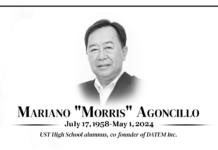UST SHOULD have posted more than just a photo-finish position in the annual survey of the top 500 universities worldwide conducted by two private firms last year, a UST official said.
Engineer Alberto Laurito, assistant to the rector for planning and development, questioned the credibility of the Times Higher Education Supplement-Quacquarelli Symonds (THES-QS) survey, which began in 2003, because the data it used to determine UST’s ranking were not accurate.
“We were told by the research representative (of THES-QS) that the data they used were personally given to them by a University personnel, but they were not able to present who or from what office it came from,” Laurito said.
“Other top local universities had repeatedly raised how seriously these rankings should be taken,” Laurito said. “Although this survey had been used for bragging rights and for recruitment purposes, to what extent should measures be taken to improve the rankings and at what cost?”
In the survey topped by the Harvard University of Boston, UST was fourth among Philippine schools that were included in the list. UST lagged behind University of the Philippines (UP), De la Salle University (DLSU), and the Ateneo de Manila University (ADMU), which were ranked 299, 392, and 494, respectively.
The THES-QS survey based its rankings on four principal criteria: research quality, teaching quality is reflected in the student and faculty ratio, graduate employability through recruiter review, and international outlook.
Laurito pointed out that the data used by THES-QS on UST were inaccurate.
“For one thing, the University’s student population on THES-QS records only 11,764, while the actual population is 32, 971,” he said.
Laurito added that THES-QS research on peer review was also irregular, considering that it was worth 40 per cent of the entire survey when only 1,600 universities turned in their responses or about one per cent of the 190,000 needed. Of the local universities included in the top 500 rankings, UP earned 19 responses, De La Salle got 10, UST received six, and Ateneo received four.
Also under the criteria of research quality, only UP had a score among the top four local universities, with one citation, the other three universities, including UST, received a flat zero. The score is obtained through a research collation database maintained by Thomson, an information-based solutions provider, called Essential Science Indicators (ESI). For every citation given to a university researcher or professor, the university would acquire a point.
“Thomson’s ESI might have provided a substantial figure on university researchers on the West and Europe, but in order to know if it fares just as the same on other countries, we should observe the gathered data.” Laurito said.
Based also on the survey, UST received the lowest grade on international outlook (meaning UST has no international students or faculty) when the University actually has seven international professors and 300 international students. When University officials gave QS the official and accurate profile of UST last January, QS research head Ben Sowter told them that they could no longer correct the survey since it had already been published.
“For now, all we can do is wait for THES-QS’ next cycle of survey this coming June,” Laurito said. “Surveys with inaccurate data are not reliable, that is why we are hoping that with a correct data, we would fare better on their 2007 survey. Marc Laurenze C. Celis














